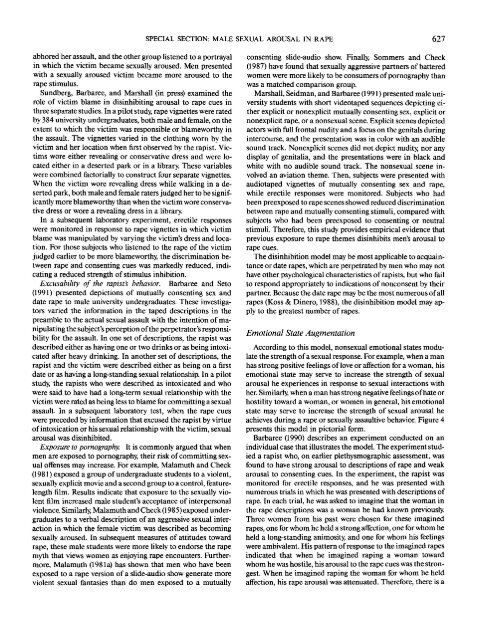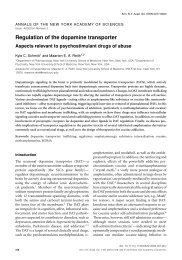The Role of Male Sexual Arousal in Rape: Six Models
The Role of Male Sexual Arousal in Rape: Six Models
The Role of Male Sexual Arousal in Rape: Six Models
Create successful ePaper yourself
Turn your PDF publications into a flip-book with our unique Google optimized e-Paper software.
abhored her assault, and the other group listened to a portrayal<br />
<strong>in</strong> which the victim became sexually aroused. Men presented<br />
with a sexually aroused victim became more aroused to the<br />
rape stimulus.<br />
Sundberg, Barbaree, and Marshall (<strong>in</strong> press) exam<strong>in</strong>ed the<br />
role <strong>of</strong> victim blame <strong>in</strong> dis<strong>in</strong>hibit<strong>in</strong>g arousal to rape cues <strong>in</strong><br />
three separate studies. In a pilot study, rape vignettes were rated<br />
by 384 university undergraduates, both male and female, on the<br />
extent to which the victim was responsible or blameworthy <strong>in</strong><br />
the assault. <strong>The</strong> vignettes varied <strong>in</strong> the cloth<strong>in</strong>g worn by the<br />
victim and her location when first observed by the rapist. Vic-<br />
tims wore either reveal<strong>in</strong>g or conservative dress and were lo-<br />
cated either <strong>in</strong> a deserted park or <strong>in</strong> a library <strong>The</strong>se variables<br />
were comb<strong>in</strong>ed factorially to construct four separate vignettes.<br />
When the victim wore reveal<strong>in</strong>g dress while walk<strong>in</strong>g <strong>in</strong> a de-<br />
serted park, both male and female raters judged her to be signif-<br />
icantly more blameworthy than when the victim wore conserva-<br />
tive dress or wore a reveal<strong>in</strong>g dress <strong>in</strong> a library<br />
In a subsequent laboratory experiment, erectile responses<br />
were monitored <strong>in</strong> response to rape vignettes <strong>in</strong> which victim<br />
blame was manipulated by vary<strong>in</strong>g the victim's dress and loca-<br />
tion. For those subjects who listened to the rape <strong>of</strong> the victim<br />
judged earlier to be more blameworthy, the discrim<strong>in</strong>ation be-<br />
tween rape and consent<strong>in</strong>g cues was markedly reduced, <strong>in</strong>di-<br />
cat<strong>in</strong>g a reduced strength <strong>of</strong> stimulus <strong>in</strong>hibition.<br />
Excusability <strong>of</strong> the rapist's behavior. Barbaree and Seto<br />
(1991) presented depictions <strong>of</strong> mutually consent<strong>in</strong>g sex and<br />
date rape to male university undergraduates. <strong>The</strong>se <strong>in</strong>vestiga-<br />
tors varied the <strong>in</strong>formation <strong>in</strong> the taped descriptions <strong>in</strong> the<br />
preamble to the actual sexual assault with the <strong>in</strong>tention <strong>of</strong> ma-<br />
nipulat<strong>in</strong>g the subject's perception <strong>of</strong> the perpetrator's responsi-<br />
bility for the assault. In one set <strong>of</strong> descriptions, the rapist was<br />
described either as hav<strong>in</strong>g one or two dr<strong>in</strong>ks or as be<strong>in</strong>g <strong>in</strong>toxi-<br />
cated after heavy dr<strong>in</strong>k<strong>in</strong>g. In another set <strong>of</strong> descriptions, the<br />
rapist and the victim were described either as be<strong>in</strong>g on a first<br />
date or as hav<strong>in</strong>g a long-stand<strong>in</strong>g sexual relationship. In a pilot<br />
study, the rapists who were described as <strong>in</strong>toxicated and who<br />
were said to have had a long-term sexual relationship with the<br />
victim were rated as be<strong>in</strong>g less to blame for committ<strong>in</strong>g a sexual<br />
assault. In a subsequent laboratory test, when the rape cues<br />
were preceded by <strong>in</strong>formation that excused the rapist by virtue<br />
<strong>of</strong> <strong>in</strong>toxication or his sexual relationship with the victim, sexual<br />
arousal was dis<strong>in</strong>hibited.<br />
Exposure to pornography. It is commonly argued that when<br />
men are exposed to pornography, their risk <strong>of</strong> committ<strong>in</strong>g sex-<br />
ual <strong>of</strong>fenses may <strong>in</strong>crease. For example, Malamuth and Check<br />
(1981) exposed a group <strong>of</strong> undergraduate students to a violent,<br />
sexually explicit movie and a second group to a control, feature-<br />
length film. Results <strong>in</strong>dicate that exposure to the sexually vio-<br />
lent film <strong>in</strong>creased male student's acceptance <strong>of</strong> <strong>in</strong>terpersonal<br />
violence. Similarly, Malamuth and Check (1985) exposed under-<br />
graduates to a verbal description <strong>of</strong> an aggressive sexual <strong>in</strong>ter-<br />
action <strong>in</strong> which the female victim was described as becom<strong>in</strong>g<br />
sexually aroused. In subsequent measures <strong>of</strong> attitudes toward<br />
rape, these male students were more likely to endorse the rape<br />
myth that views women as enjoy<strong>in</strong>g rape encounters. Further-<br />
more, Malamuth (1981a) has shown that men who have been<br />
exposed to a rape version <strong>of</strong> a slide-audio show generate more<br />
violent sexual fantasies than do men exposed to a mutually<br />
SPECIAL SECTION: MALE SEXUAL AROUSAL IN RAPE 627<br />
consent<strong>in</strong>g slide-audio show. F<strong>in</strong>ally, Sommers and Check<br />
(1987) have found that sexually aggressive partners <strong>of</strong> battered<br />
women were more likely to be consumers <strong>of</strong> pornography than<br />
was a matched comparison group.<br />
Marshall, Seidman, and Barbaree (1991) presented male uni-<br />
versity students with short videotaped sequences depict<strong>in</strong>g ei-<br />
ther explicit or nonexplicit mutually consent<strong>in</strong>g sex, explicit or<br />
nonexplicit rape, or a nonsexual scene. Explicit scenes depicted<br />
actors with full frontal nudity and a focus on the genitals dur<strong>in</strong>g<br />
<strong>in</strong>tercourse, and the presentation was <strong>in</strong> color with an audible<br />
sound track. Nonexplicit scenes did not depict nudity, nor any<br />
display <strong>of</strong> genitalia, and the presentations were <strong>in</strong> black and<br />
white with no audible sound track. <strong>The</strong> nonsexual scene <strong>in</strong>-<br />
volved an aviation theme. <strong>The</strong>n, subjects were presented with<br />
audiotaped vignettes <strong>of</strong> mutually consent<strong>in</strong>g sex and rape,<br />
while erectile responses were monitored. Subjects who had<br />
been preexposed to rape scenes showed reduced discrim<strong>in</strong>ation<br />
between rape and mutually consent<strong>in</strong>g stimuli, compared with<br />
subjects who had been preexposed to consent<strong>in</strong>g or neutral<br />
stimuli. <strong>The</strong>refore, this study provides empirical evidence that<br />
previous exposure to rape themes dis<strong>in</strong>hibits men's arousal to<br />
rape cues.<br />
<strong>The</strong> dis<strong>in</strong>hibition model may be most applicable to acqua<strong>in</strong>-<br />
tance or date rapes, which are perpetrated by men who may not<br />
have other psychological characteristics <strong>of</strong> rapists, but who fail<br />
to respond appropriately to <strong>in</strong>dications <strong>of</strong> nonconsent by their<br />
partner. Because the date rape may be the most numerous <strong>of</strong> all<br />
rapes (Koss & D<strong>in</strong>ero, 1988), the dis<strong>in</strong>hibition model may ap-<br />
ply to the greatest number <strong>of</strong> rapes.<br />
Emotional State Augmentation<br />
Accord<strong>in</strong>g to this model, nonsexual emotional states modu-<br />
late the strength <strong>of</strong> a sexual response. For example, when a man<br />
has strong positive feel<strong>in</strong>gs <strong>of</strong> love or affection for a woman, his<br />
emotional state may serve to <strong>in</strong>crease the strength <strong>of</strong> sexual<br />
arousal he experiences <strong>in</strong> response to sexual <strong>in</strong>teractions with<br />
her. Similarly, when a man has strong negative feel<strong>in</strong>gs <strong>of</strong> hate or<br />
hostility toward a woman, or women <strong>in</strong> general, his emotional<br />
state may serve to <strong>in</strong>crease the strength <strong>of</strong> sexual arousal he<br />
achieves dur<strong>in</strong>g a rape or sexually assaultive behavior. Figure 4<br />
presents this model <strong>in</strong> pictorial form.<br />
Barbaree (1990) describes an experiment conducted on an<br />
<strong>in</strong>dividual case that illustrates the model. <strong>The</strong> experiment stud-<br />
ied a rapist who, on earlier plethysmographic assessment, was<br />
found to have strong arousal to descriptions <strong>of</strong> rape and weak<br />
arousal to consent<strong>in</strong>g cues. In the experiment, the rapist was<br />
monitored for erectile responses, and he was presented with<br />
numerous trials <strong>in</strong> which he was presented with descriptions <strong>of</strong><br />
rape. In each trial, he was asked to imag<strong>in</strong>e that the woman <strong>in</strong><br />
the rape descriptions was a woman he had known previously<br />
Three women from his past were chosen for these imag<strong>in</strong>ed<br />
rapes, one for whom he held a strong affection, one for whom he<br />
held a long-stand<strong>in</strong>g animosity, and one for whom his feel<strong>in</strong>gs<br />
were ambivalent. His pattern <strong>of</strong> response to the imag<strong>in</strong>ed rapes<br />
<strong>in</strong>dicated that when he imag<strong>in</strong>ed rap<strong>in</strong>g a woman toward<br />
whom he was hostile, his arousal to the rape cues was the stron-<br />
gest. When he imag<strong>in</strong>ed rap<strong>in</strong>g the woman for whom he held<br />
affection, his rape arousal was attenuated. <strong>The</strong>refore, there is a










